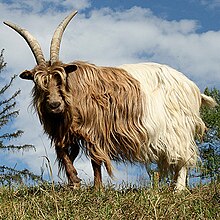Copper neck goat
The copper- necked goat was introduced in 2007 by the ProSpecieRara foundation but has not yet been established in the specialist literature for a rare variant of the Valais black-necked goat , namely for specimens of this breed that are characterized by reddish-brown instead of black fur on the front half of their body.
Appearance features
Even in black-necked goats with the usual coloration, the upper layers of the fur are often bleached when exposed to intense sunlight. The copper-necked goat differs from this by the reddish coloration of the lower layers of fur as well as the hair on the head and legs.
distribution
Around 200 living specimens were known in autumn 2013, most of them in the Mattertal in Upper Valais , and further specimens in the Bernese Oberland, among others . By the end of 2016 the number rose to just under 560. The copper necked goat can now be found all over Switzerland.
According to ProSpecieRara, copper-necked goats have appeared again and again in the past decades as specimens of different colors in the herd of common black-necked goats, but have not been included in the herdbook by breeders due to their coloration differing from the breed type, but mostly sorted out and slaughtered immediately after birth.
The fact that such animals also appeared in groups in the past century could suggest a description from 1890, according to which at that time a "strong troop of large, magnificent animals, brown on the front half of the body, milk white on the back" were sighted at that time on the Rhone glacier Coloring differed from the black-necked goats observed at the same time in the nearby Mattertal with their usual coloration. However, it is not known whether this was also a congenital coloration or a coloration caused only by exposure to light.
Emergence
At the beginning of the rescue project in 2006, ProSpecieRara suspected a recessive gene from the genetic make-up of the copper goat , which was widespread in the Copper Age and is now extinct and is considered the ancestor of the black-necked goat , as the cause of the different coloring . The extinct copper goat does not get its name from the color of its fur, which is unknown, but from its appearance in the Copper Age. A DNA analysis carried out by the ProSpecieRara Foundation in collaboration with the Institute for Genetics of the University of Bern in 2014 showed that the copper color is predominantly inherited over the recessive black and that copper-necked goats probably carry both color genes.
Conservation project
In autumn 2006 the animal welfare organization ProSpecieRara began researching this type and started a conservation project in spring 2007. Around twenty animals were reported on request, and in March 2008 a first meeting of breeders of the copper-necked goat took place. Since the start of the project in 2006, ProSpecieRara has been able to distribute breeding groups in different regions of Switzerland.
Individual evidence
- ↑ rara. The ProSpecieRara magazine, issue 2/2017, p. 27.
- ↑ Friedrich von Tschudi: Das Tierleben der Alpenwelt , 11th edition, Weber, Leipzig 1890, quoted by ProSpecieRara
- ↑ Kupferhalsziege on provieh.de
Web links
- Copper- necked goat on ProSpecie Rara


